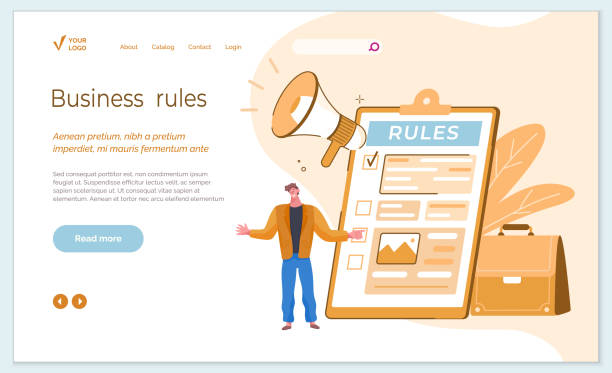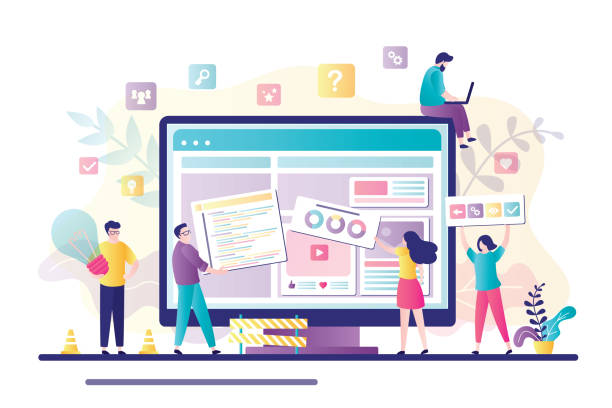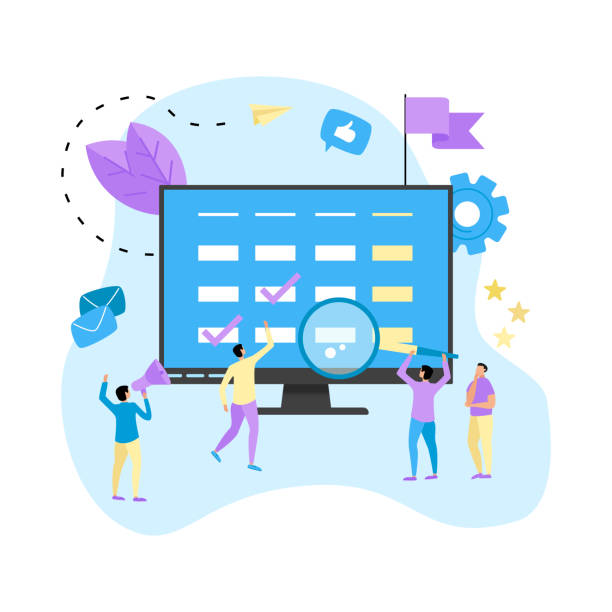The Importance of Multilingual Website Design in Today’s World

In this era of #globalization and the increasing growth of #e_commerce, access to international markets is vital for any business.
Multilingual website design is no longer a luxury option, but a strategic necessity.
This approach allows you to overcome language barriers and reach a wider audience across the globe.
A multilingual website not only opens new markets for your business but also enhances your brand’s credibility and image internationally.
When visitors from different countries can view your content in their native language, they feel more comfortable and trusting of your brand, which in turn leads to increased conversion rates and customer loyalty.
This section provides a deep explanation of why and the importance of this type of design. Many companies lose countless opportunities for global growth and development by ignoring this important aspect.
With a localized website, you can establish stronger connections with potential customers in different countries and gain a better understanding of their needs and cultural preferences.
This creates a significant competitive advantage in global markets and strengthens your online presence.
Beyond mere text translation, a professional multilingual website design includes adapting content to the culture and local needs of each region, which itself requires an analytical and precise approach.
Are you tired of losing business opportunities due to not having a professional corporate website?
RasaWeb helps you with professional corporate website design to:
✅ Build a powerful and credible image for your brand
✅ Convert website visitors into loyal customers
⚡ Get a free consultation now!
Challenges and Opportunities of Implementing a Multilingual Website

Implementing a multilingual website comes with a set of challenges and unique opportunities.
From a technical perspective, managing URL structures, hreflang tags for SEO, and ensuring CMS compatibility with multilingual content are among the most important obstacles.
The main challenge in this area is maintaining data integrity and preventing content duplication. The primary opportunity, however, lies in expanding the market and reaching audiences who were previously unable to interact with your website due to language barriers.
Each new language opens up a new market with high growth potential for you.
From a content perspective, simple translation is not enough; content localization, which includes cultural and social adaptation, is of great importance.
A specialized approach in this area ensures that your message is conveyed correctly and with consideration for cultural differences.
This can include changes in images, colors, and even examples used in the content to better connect with the local audience.
Another opportunity in this section is the improvement of international SEO.
By correctly using hreflang tags and targeting keywords for each language, you can improve your website’s ranking in search engines for different markets.
This aspect provides valuable guidance for technical and marketing teams.
Technical Principles and Choosing the Right Platform for Multilingual Sites

Choosing the right platform and adhering to technical principles are the foundation of a successful multilingual website design.
Content management systems (CMS) such as WordPress with multilingual plugins like WPML or Polylang, Drupal with native multilingual capabilities, or Joomla, are popular options.
Each of these has its own advantages and disadvantages.
Making the right decision at this stage can significantly reduce future complexities. For example, WordPress, with its vast user community and numerous plugins, is suitable for small and medium-sized businesses, while Drupal is recommended for larger, more complex projects with high customization needs.
From a technical perspective, there are three main methods for structuring URLs for multilingual websites:
| URL Structuring Method | Example | Advantages | Disadvantages |
|---|---|---|---|
| Subdirectories | yoursite.com/en/, yoursite.com/fa/ |
Stronger SEO (shared domain authority), easier maintenance | More complex content management in some CMS |
| Subdomains | en.yoursite.com, fa.yoursite.com |
Clear language separation, high scalability | May require separate SEO for each subdomain |
| Country-code Top-Level Domains (ccTLDs) | yoursite.co.uk, yoursite.ir |
Very strong geographical targeting, high local trust | High cost, need to manage multiple domains |
Additionally, the database must be capable of storing multilingual content and support Unicode (UTF-8).
These tips are educational and specialized, and essential for any multilingual website design. The right choice at this stage can ensure the stability and performance of your website in the long run.
Multilingual Content and SEO Optimization
![]()
Search engine optimization (SEO) on a multilingual website is critically important.
Simply translating content is not enough; the SEO strategy must be developed independently for each language and region.
The first step is the correct use of the hreflang tag, which informs search engines like Google and Bing that different versions of a page exist for different languages or regions.
This tag prevents duplicate content issues and helps users find the appropriate language version.
Keyword research must also be conducted locally for each language, as direct translation of keywords may not yield desired results; frequently used keywords in one language may have a different meaning or search volume in another.
This is a specialized process that requires deep knowledge of the target culture and language. Also, the URL structure and file names should clearly indicate the target language (e.g., /en/page or /fa/page).
Using Google and Bing Webmaster Tools for geographical targeting is also very important.
An analytical approach to monitoring SEO performance in each language is essential. Local link-building and acquiring backlinks from relevant websites in each country can also significantly improve SEO rankings.
All these steps help improve your ranking in search results and ensure that your multilingual website design is properly optimized.
Dreaming of a thriving online store but don’t know where to start?
RasaWeb is your comprehensive solution for e-commerce website design.
✅ Attractive and user-friendly design
✅ Increased sales and revenue⚡ Get a free consultation
User Experience (UX) in Multilingual Website Design

User experience (UX) is of particular importance in multilingual website design and goes beyond mere content translation.
Users should be able to easily select their desired language and browse the entire website in that language.
The placement of the language switch button (usually in the header or footer) and its clarity are important design considerations.
Studies have shown that poor UX can lead to the loss of many users. Furthermore, user interface (UI) design should take into account cultural and linguistic differences.
For example, the reading direction of text in Persian (right-to-left) differs from English (left-to-right), and this must be carefully considered in the design of page layouts, forms, and even images.
This educational section emphasizes the importance of user testing with native speakers to ensure a smooth and flawless experience. Page loading speed in different geographical regions is also a crucial factor in UX.
Using content delivery networks (CDNs) can help improve this.
Font types, colors, and icons should also be culturally compatible to avoid any misunderstanding or negative perception.
This aspect of multilingual website design challenges questionable content regarding best practices. Website navigation should be designed so that users in any language can easily find the information they need without feeling confused.
A successful multilingual website design requires a deep understanding of the psychology and expectations of users in each region.
Localization Beyond Mere Translation

Localization goes beyond simple translation; this process involves fully adapting content and user experience to the culture, customs, and expectations of local audiences.
While translation converts text from one language to another, localization delves into deeper aspects.
This includes adapting units of measurement, date and time formats, phone number and address formats, and even local currency. For example, a marketing campaign that was successful in one country might be completely unsuccessful in another due to cultural differences.
The images used on the website, the tone of the content, and even the colors should be chosen with cultural sensitivity to avoid conveying any unintended or offensive messages.
This aspect of multilingual website design raises questionable content regarding a true understanding of global audiences. Legal and privacy issues must also be considered in the localization process.
Data collection regulations (such as GDPR in Europe) and terms and conditions must be adapted for each specific region.
A strong analytical approach to understanding target markets is essential. This process transforms a multilingual website from a merely translated tool into a powerful and impactful communication platform that connects with audiences on a deeper level.
Localization makes users feel that the website has been specifically designed for them, which significantly increases brand loyalty and serves as a practical guide for entering new markets.
Efficient Tools and Techniques for Multilingual Content Management

Managing multilingual content can be complex, but with the right tools and techniques, this process becomes significantly simpler.
Translation Management Systems (TMS) such as Smartling, Phrase, or Lokalise are powerful tools that enable managing translation projects, collaboration between translators and reviewers, and maintaining terminology consistency.
These tools are particularly useful for large websites with dynamic content and continuous updates.
Additionally, many Content Management Systems (CMS) like WordPress through plugins and Drupal natively, offer multilingual management capabilities.
Using automatic translation APIs (such as Google Cloud Translation) can be used as a supplementary tool for initial translations or non-sensitive content, but it can never replace professional human translation and precise localization.
This is an expert recommendation: always have critical content reviewed by human translators.
| Tool/Technique | Primary Use | Advantages | Disadvantages |
|---|---|---|---|
| Translation Management Systems (TMS) | Management and collaboration in translation projects | High efficiency, integrity, translation memory | High cost, requires training |
| Multilingual CMS Plugins | Multilingual capabilities in common CMS | Easy integration, familiarity with CMS environment | Limitations in advanced translation features |
| Machine Translation APIs | Automated text translation | High speed, low cost for large volumes | Lower accuracy, lack of localization |
Another technique is the use of Translation Memory (TM) and Terminology Bases, which help maintain consistency in translations and reduce time and cost in the long run.
These are educational tools for teams involved in multilingual website design and management.
Maintenance and Updates of a Multilingual Website

After launch, continuous maintenance and updates of a multilingual website are crucial for maintaining its performance, security, and credibility.
This process includes technical updates of the platform (CMS, plugins, themes), content updates in all languages, and performance and security monitoring.
Any update to the primary version of the website must be quickly reflected in other language versions to prevent information discrepancies.
This requires a systematic and coordinated approach.
Website security across all languages should be continuously monitored.
Any vulnerability can harm the credibility of the entire website.
Additionally, monitoring website performance through web analytics tools such as Google Analytics for each language is very important.
This allows you to track traffic, user behavior, and conversion rates in different markets and adjust your strategies based on real data.
This is an important news item, as companies that neglect regular updates face high security risks. A/B testing for different elements (such as titles, calls to action) in different languages can help continuously optimize user experience and conversion rates.
This specialized maintenance ensures that your multilingual website design always remains efficient and attractive.
Are you tired of your company’s website not being seen as it deserves, and losing potential customers?
With professional and effective website design by RasaWeb, solve this problem forever!
✅ Increase brand credibility and gain customer trust
✅ Attract targeted sales leads
⚡ Contact us now for a free consultation!
Measuring Success and the Future of Multilingual Website Design

Measuring the success of a multilingual website design requires defining key performance indicators (KPIs) for each language and region.
These indicators can include website traffic from different countries, conversion rates for each language, user session duration, bounce rates, and keyword rankings in local search engines.
Detailed analysis of this data provides valuable insights into website performance and areas needing improvement. Web analytics tools help you collect and interpret this information.
The future of multilingual website design is also intertwined with technological advancements.
Artificial intelligence and machine learning will play an increasing role in more advanced machine translation and automated localization.
Instant and accurate translation, multilingual speech recognition, and AI-based question-answering systems will personalize the user experience even further.
Additionally, multilingual voice and visual search will revolutionize how users interact with websites.
This analytical perspective can be entertaining for you as it looks at future potentials. Companies must be prepared to adapt to these changes and invest in emerging technologies to maintain their competitive advantage.
Continuous monitoring of trends and innovations in this field is vital for any business seeking a global presence and provides the necessary guidance for strategic planning.
Practical Steps to Start Your Multilingual Website Design Project

Starting a multilingual website design project requires careful planning and specific practical steps.
The first step is defining goals and target audiences.
Which languages and countries are a priority for your business? This decision is based on market research, current website traffic data, and growth potential.
Then, you need a realistic budget that includes translation, localization, technical development, maintenance, and multilingual SEO costs.
Choosing a specialized team or web development company with experience in multilingual website design is of paramount importance. This team should have both technical knowledge and be familiar with the content and cultural challenges of localization.
After selecting the platform (as explained in previous sections), the process of collecting and preparing content for translation begins.
Ensuring high-quality translation and localization is vital; therefore, collaboration with professional native translators specializing in your field is recommended.
Finally, after launch, continuous monitoring and analysis of website performance in each language are essential for ongoing optimization and improvement.
These guiding and specialized steps will assist you in building and developing a successful multilingual site, ensuring a structured approach from start to finish.
Frequently Asked Questions
| Question | Answer |
|---|---|
| What is multilingual website design? | The process of creating a website whose content is available to users in more than one language. |
| Why should I make my site multilingual? | To reach more audiences globally, improve user experience for non-native speakers, and increase sales or engagement. |
| What are the methods for implementing a multilingual site? | Using subdomains, subdirectories, or URL parameters, or using different Top-Level Domains (TLDs) for each language. |
| Which method is better for SEO? | Generally, using subdirectories (e.g., example.com/fa/) is recommended for SEO, as they share the main domain’s authority. |
| What is the hreflang tag and what is its use? | The hreflang tag is an HTML attribute that helps search engines understand which version of a page is appropriate for a specific language or region. |
| Is machine translation sufficient for multilingual site content? | Usually not. For a good user experience and to maintain credibility, professional translation and content localization are essential. |
| What does Localization mean? | The process of adapting the content, design, and functionality of a site to the culture, language, currency, and other specific characteristics of a target region or country. |
| What is the importance of language selection in multilingual website design? | Users should be allowed to easily select their desired language, typically via a clear button or menu in the site’s header. |
| What are the challenges in multilingual website design? | Managing content in different languages, maintaining consistency in design and user experience, multilingual SEO, and translation and maintenance costs. |
| What features should a suitable Content Management System (CMS) for a multilingual site have? | It should allow easy management of content in different languages, support multilingual URL structures, and offer plugins related to translation and localization. |
And other services of Rasa Web Advertising Agency in the field of advertising
Smart Marketplace: A creative platform for improving website traffic with attractive UI design.
Smart Sales Automation: A creative platform for improving click-through rates by optimizing key pages.
Smart Direct Marketing: Designed for businesses seeking online growth through attractive UI design.
Smart Data Analysis: A fast and efficient solution for increasing click-through rates with a focus on marketing automation.
Smart Advertorials: A novel service for increasing digital branding through custom programming.
And over hundreds of other services in the field of internet advertising, advertising consultation, and organizational solutions
Internet Advertising | Advertising Strategy | Advertorial
Resources
Multilingual Website Design Guide
Principles of Professional Website Design
SEO Optimization for Multilingual Sites
Web Development Trends in Iran
? Ready to transform your business in the digital world? RasaWeb Digital Marketing Agency offers comprehensive solutions, including e-commerce website design, search engine optimization, and social media management, paving your path to online success. Contact us today and revolutionize the future of your business.
📍 Tehran, Mirdamad Street, next to Bank Markazi, Kazeroun Jonoubi Alley, Ramin Alley No. 6



